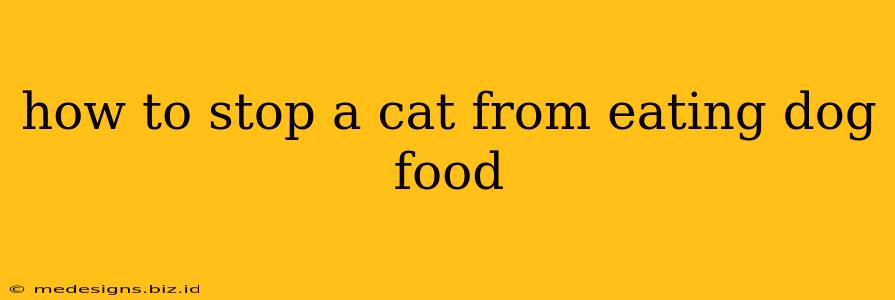Cats, with their discerning palates and insatiable curiosity, sometimes develop a taste for things they shouldn't—like dog food. While a small amount of dog food probably won't harm your cat, consistent consumption can lead to nutritional imbalances and digestive issues. This comprehensive guide will help you understand why your cat is attracted to dog food and provide effective strategies to break this habit.
Understanding Why Your Cat Eats Dog Food
Before we dive into solutions, it's crucial to understand the underlying reasons behind your cat's behavior. Several factors can contribute to this undesirable habit:
- Taste and Smell: Dog food, especially those with strong meaty flavors and aromas, can be incredibly tempting to cats. The high fat content is particularly alluring.
- Nutritional Deficiency: Your cat might be seeking specific nutrients missing in their diet. A lack of taurine, for instance, can cause serious health problems.
- Boredom or Attention-Seeking: If your cat is bored or feeling neglected, they may resort to eating dog food as a way to gain attention or alleviate boredom.
- Food Aggression/Competition: In multi-pet households, a cat might be trying to compete with the dog for food resources.
Effective Strategies to Deter Your Cat from Dog Food
Here are some practical and effective strategies to curb your cat's canine culinary cravings:
1. Secure the Dog Food
This might seem obvious, but ensuring your dog's food is inaccessible to your cat is the first line of defense. Consider these options:
- Elevated Food Bowls: Place your dog's food bowl on a raised stand or table that your cat can't reach.
- Closed Containers: Store dog food in airtight, sealed containers that your cat can't open.
- Separate Feeding Areas: Feed your dog and cat in separate rooms or areas to minimize temptation and competition.
2. Enrich Your Cat's Diet
A balanced and nutritious cat diet can significantly reduce the appeal of dog food.
- High-Quality Cat Food: Transition your cat to a high-quality cat food that meets their nutritional needs. Look for foods specifically formulated for adult cats or kittens, depending on your cat's age.
- Food Puzzles: Introduce interactive food puzzles or toys to stimulate your cat mentally and make mealtimes more engaging. This can alleviate boredom and reduce the likelihood of food scavenging.
- Consult a Veterinarian: If you suspect a nutritional deficiency, consult your veterinarian. They can perform a checkup and recommend dietary adjustments.
3. Manage Your Cat's Behavior
Behavioral modifications can help address attention-seeking or boredom-related issues:
- Increased Playtime: Engage your cat in more playtime with interactive toys to reduce boredom and provide mental stimulation.
- Positive Reinforcement: Reward your cat with treats and praise when they stay away from the dog food.
- Vertical Space: Provide plenty of vertical space for your cat, such as cat trees or shelves, to allow them to escape and feel secure.
4. Use Deterrents
While not always effective, certain deterrents can help discourage your cat:
- Citrus Scents: Cats generally dislike citrus scents. Place orange or lemon peels near the dog food bowl. (Note: Ensure your dog isn't bothered by the scent!)
- Motion-Activated Sprinklers: These can startle your cat and discourage them from approaching the dog food area. (Use with caution to avoid scaring your pet excessively.)
Consistency is Key
Remember that breaking this habit takes time and consistency. Be patient, persistent, and celebrate even small successes. By implementing these strategies, you can effectively deter your cat from eating dog food and ensure they receive the proper nutrition they need to thrive. If the problem persists despite your efforts, consult your veterinarian to rule out any underlying health issues.
